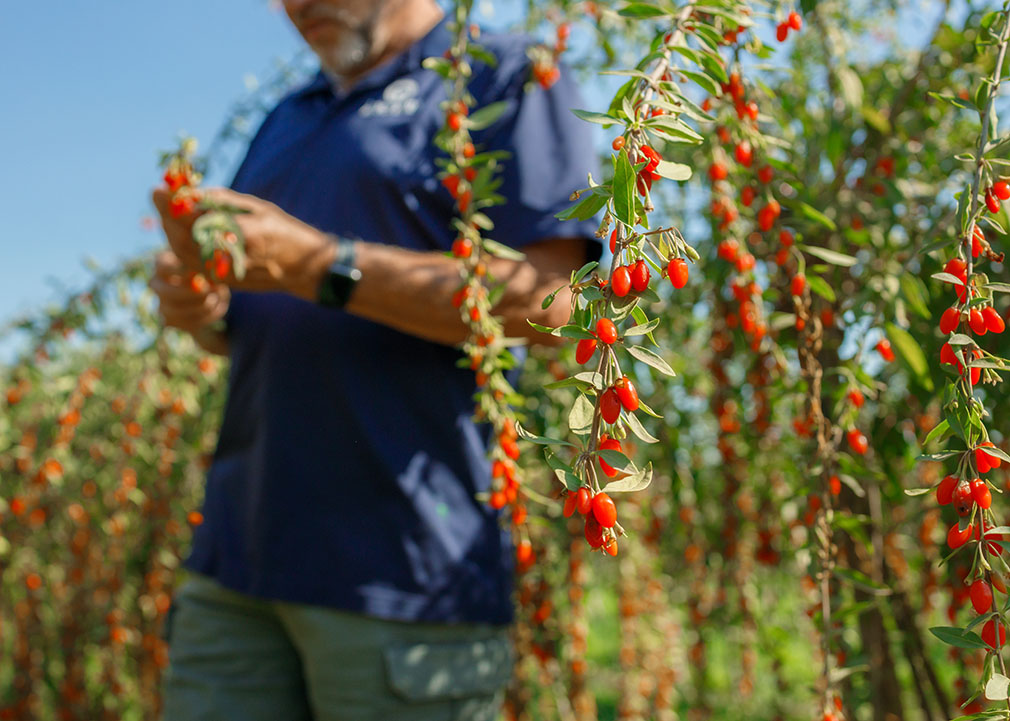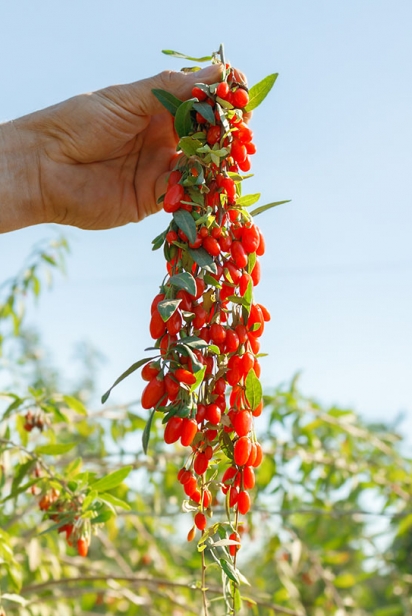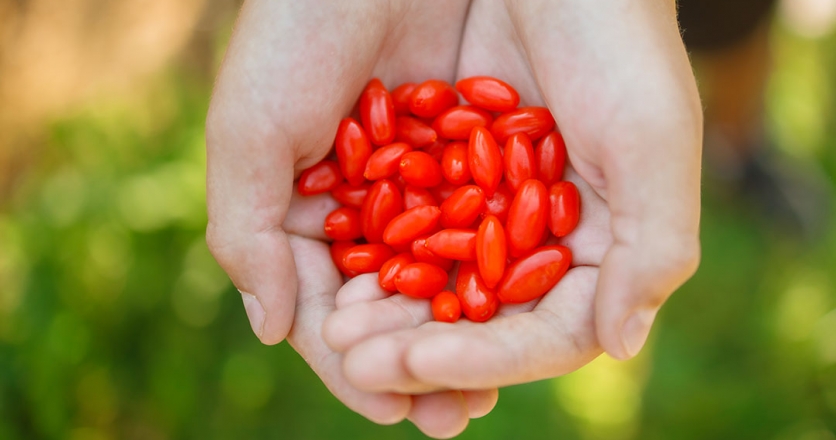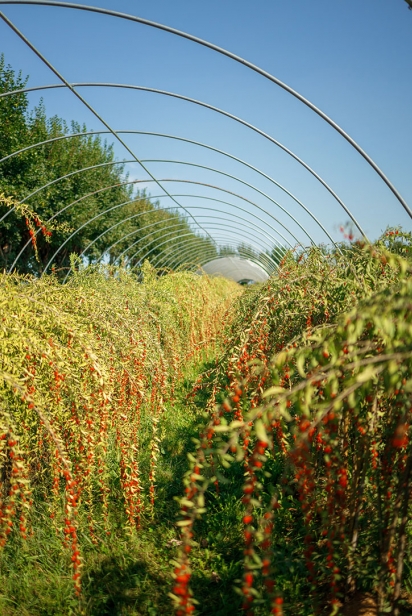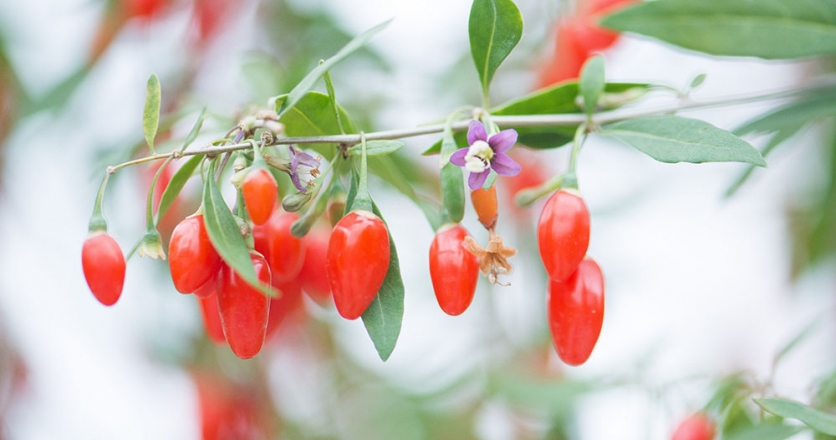A Berry Good Harvest
It’s late summer on the Taves family farm near Abbotsford, and the annual fruit harvest is in full swing. Known as the Applebarn, the farm is brimming with pies and pressed cider, adorable baby goats playing in the pasture and hayrides through the orchards of stout apple trees. It’s a prime spot for a family outing in the country, but there’s more for the U-pick crowds to sample this year. Beyond the fresh Honey Crisp, Fuji and Taves’ signature Jonagold apples, visitors are lining up to pick goji berries, a rare fruit in these parts.
What’s a goji berry?
You can be forgiven if you’ve never heard of — let alone tasted — a fresh goji berry.
Native to northern China, Tibet and Mongolia, the goji berry (also known as wolfberry) is the fruit of the Lycium barbarum, a member of the nightshade family, related to tomatoes, potatoes and tobacco.
It’s a sprawling, dramatic-looking plant when laden with bright red berries in August. The teardrop-shaped fruits hang along the arching branches like miniature peppers or tiny grape tomatoes.
The fruit and young leaves are highly nutritious, and goji berries have long been important in traditional Chinese medicine. The Chinese brew the berries, which are high in vitamin C, carotenoids, trace minerals and fibre, into “tonic” soups and teas, with claims that their antioxidants and nutrients can boost immunity, cleanse the liver and even lead to long life.
Today, goji berries are touted as the latest in a line of “superfoods” and anti-aging elixirs. Devotees often add them to smoothies and energy drinks or buy them as supplements.
Though most of the health claims are unproven, some scientific studies suggest the high levels of antioxidants and vitamins in the tiny fruit can protect against age-related macular degeneration, support the immune system, slow cancerous tumour growth, stabilize blood sugar, improve sleep and slow alcohol-related liver damage. They are loaded with various phytochemicals, have 15 times the iron of spinach, have some of the highest levels of beta-carotene among edible plants, and are a source of complete protein containing all nine amino acids.
When dried, one-third of a cup (40 grams) of goji berries contains 140 calories, no fat, 18 grams of sugar and 6 grams of protein.
There are no major side effects to consuming fresh or dried goji berries. Still, they may negatively interact with blood pressure medications and diabetes drugs, so experts advise consulting a doctor before using supplements.
Goji berries in B.C.
It was greenhouse grower Peter Breederland who pioneered growing goji berries in B.C. A Dutch-trained horticulturist, he grew greenhouse tomatoes and peppers, then launched his line called Gojoy a decade ago, bringing the exotic fruit to market in 2015. When he retired in 2020, Loren Taves, a fellow greenhouse grower, purchased Breederland’s 400 potted goji berry plants and planted them on a quarter-acre plot in the corner of his busy fruit and vegetable farm.
Though apples have long been the staple of the Taves family’s farm, a fixture in the Southlands of Abbotsford since the 1930s, every generation has added its stamp of innovation to the operation.
Today, there are 60 acres in production, with eggplant and heirloom tomatoes, pumpkins and a variety of berries, including gooseberries, currants and now the goji berry. The 10-acre apple orchard supports the farm’s popular U-pick operation and Applebarn products (from fresh pressed apple cider to pie filling and preserves). There’s a new Taves Estate Cidery, producing a variety of hard apple ciders, including one infused with nutrient-rich goji berries.
“We are in the thick of the harvest now and started two weeks ago,” Taves said in late August. “These plants are incredibly vigorous and produce berries on the vines that grow in the same year.”
Taves trains the plants into a single stem and trellises their willowy six-foot branches (canes) along a wire, like grapes in a vineyard, to make picking easier. At the end of the season, he prunes them back to a compact, central ball, “where next year’s new growth will come again.”
“The vines grow four to six feet tall and flower out over an extended period, [with a] harvest time of up to four weeks,” he adds.
And though not specifically grown organically, Taves says the goji berries in his orchard are virtually disease and pest-free, requiring none of the interventions of other berry crops.
“Peter Breederlan cultured them and spent a lot of time finding the right variety to grow here in B.C.,” Taves says.
Dried or fresh fruit?
If you’ve eaten goji berries, they were likely dried, a raisiny brick-coloured berry most often sold for medicinal rather than culinary use. And though once the strict domain of health food stores and Chinese herbalists, dried goji berries have gone mainstream, thanks to their reputation as a superfood.
It’s not uncommon to see dried goji berries in trail mixes, energy or granola bars, puréed in smoothies, added to breakfast bowls, even scattered across healthy salads or brewed up in herbal teas. You can use them like raisins or dried cranberries, chopped almonds or pistachios, and in muffins, biscotti or dark chocolate bark.
Some B.C. chefs and food producers have featured local goji berries in goat cheese, pepper jelly and ice cream.
But goji berries are fragile, so they are not often sold fresh, says Taves, the only grower in B.C., and who produces a tonne of goji berries yearly. He says that the berries are also very light, so it’s hard to justify paying the crews to pick by hand. That’s why the U-pick operation makes sense.
“We used to take them to farmers’ markets, but they quickly become soft when transported,” says Taves.
“We’re now using a machine to pick them, packaging into 150-gram and 400-gram bags, and putting them directly into the freezer to sell on the farm,” he adds. “We are also drying them this year, and some of the berries are used in our goji berry and apple cider.”
The creative grower is also riffing on other ideas for his small crop.
“In 2020, we opened a bar and lounge on the farm, and we might do a distillery to build on our brand and flavours,” he says, adding that the Taves Estate Cider is available in retail stores, bars and eateries around Vancouver and the Lower Mainland.
Most of the world’s goji berries are grown in China. Still, there are also growers across North America, including Goji Farm USA, the largest in North America, which produces goji berries in California and Washington State.
But you could also plant goji in your backyard. The thorny bushes are hardy in zones six to nine and reach a size of six to eight feet. They are self-pollinating and prolific, preferring sun or dappled shade and alkaline soil. They are heavy feeders, requiring regular fertilization. You can even try planting your goji in a large pot to keep the plant in check. The red berries ripen in late summer and fall, and you can add the nutritious young leaves to your salads or infuse them in teas.
Cooking with goji berries
And how do they taste? The fresh berries have been described as “bland and slightly bitter” or “tangy and bittersweet.”
Taves admits he likes the flavour of goji berries now, but it’s been an acquired taste. The fruit is sweet up front, he says, but with green, herbaceous notes and a slightly bitter finish. He describes the goji as “very bright, with a distinct savoury flavour” and says the fruit is “like a cross between a berry and a tomato.”
Taves says most experts agree that drying improves the flavour of goji berries — it brings out their natural sugars and masks any bitterness.
The dried berries have a mild flavour that hints of dates and cranberries when hydrated. That’s probably why they make good additions to savoury salads and broths and match with dark chocolate and citrus zest. Taves says his team has perfected its Genji’s Goji Berry Cider, the sweet, spicy, salmon-coloured apple cider with goji berries, ginger and raspberries.
Chefs Matt Nichols and Jeff Massey, co-owners of Restaurant 62 in Abbotsford, used the local goji berries in the salad course for the recent Taste of Abby food festival dinner — heirloom tomatoes with Mt. Lehman buffalo fresco, cucumber, puffed quinoa, Hunters’ Dale lemon basil and goji berry dressing.
“The goji berries add the brightness and acidity to the vinai- grette,” says Massey, who describes the flavour of the fresh ber- ries as sweet with crab apple or quince notes. “They have a fair bit of sweetness, but there’s a tannic structure in the skin.”
Restaurant 62 focuses on local ingredients. Massey says he and Nichols have used the fresh and frozen berries in sweet and savoury dishes — puréed with shallots, rosemary and sage as a sauce for roast pork and blitzed into a sorbet for a late-season dessert.
Because dried goji berries can be quite hard and chewy, you can quickly rehydrate them in water before adding them to your dishes or puréeing them for sauces and sorbets.
In her eponymous cookbook, Susanna Foo Chinese Cuisine, the revered Asian American chef describes how her mother simmered chicken with dried “go chi” berries and ginger. The family dips the tender boiled chicken in soy sauce before drinking the nutritious broth. Foo also adds goji berries to the vinaigrette for her Lotus Salad and includes a recipe for Brandied Go Chi, the dried berries plumped in orange juice and brandy.
In Beyond the Great Wall: Recipes and Travels in the other China, Naomi Duguid writes that the berries “have played a role in traditional Chinese medicine for centuries, as a food that is beneficial to the kidneys and liver, nourishes the blood and is good for the eyes.” She recommends brewing them as tea or adding them to the water before boiling her pork and leek dumplings.
So add a new ruby-red berry to your shopping list — whether dried or fresh, the goji is an exotic and healthy B.C. fruit.
Taves Family Farms Applebarn
333 Gladwin Rd., Abbotsford, B.C.
tavesfamilyfarms.com | 604.853.3108


